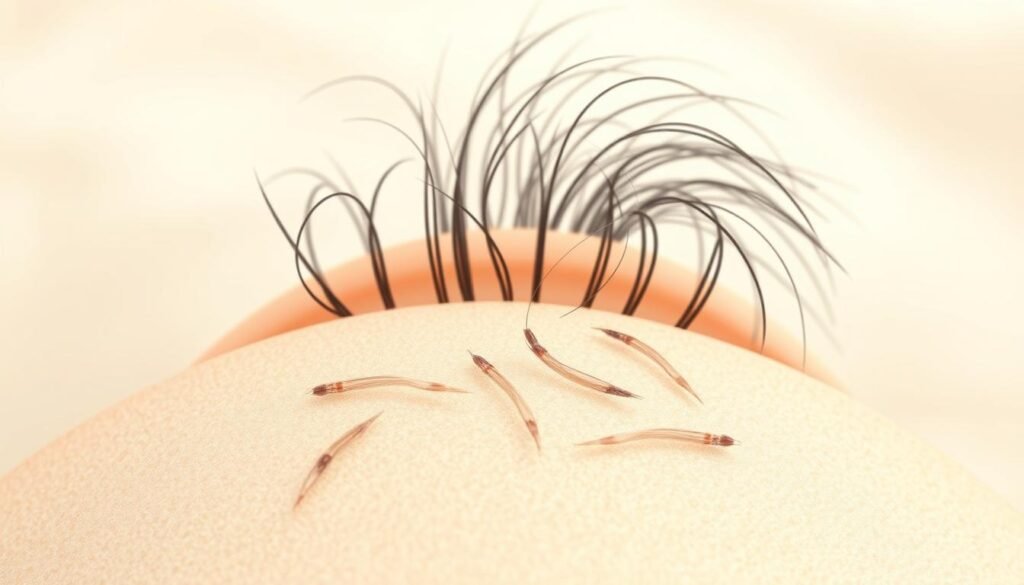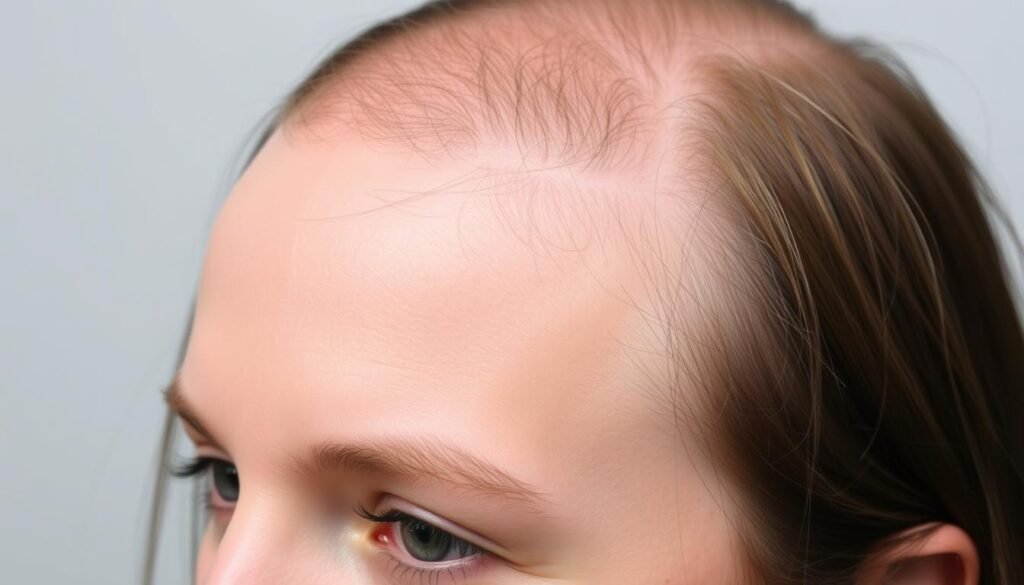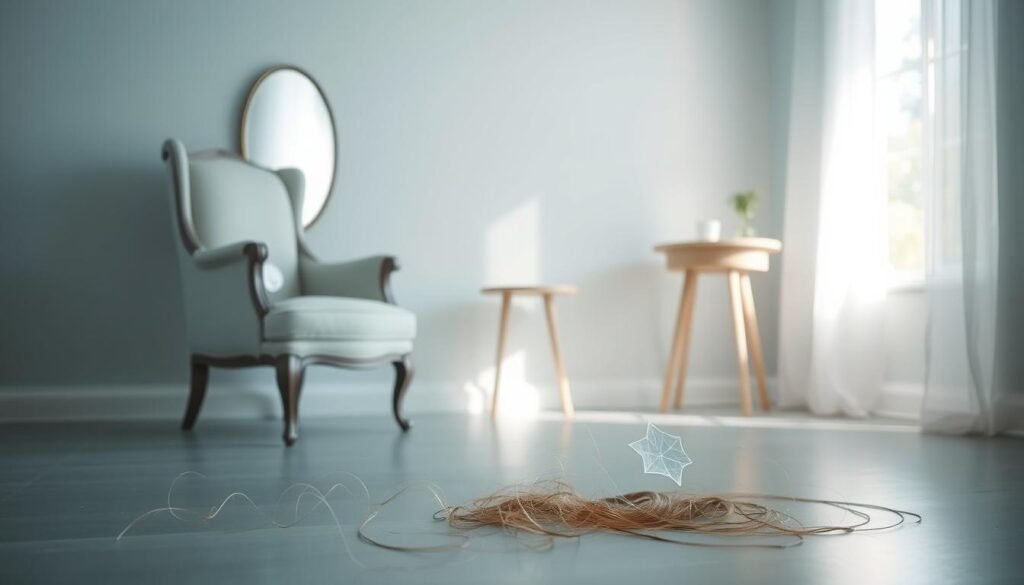About 2% of the world’s population is affected by Alopecia Areata. This shows how common hair loss problems are. This guide covers the different types of alopecia. It explains each condition, its causes, effects, and treatments. Up to 50% of men over 50 face male pattern hair loss. Meanwhile, 40% of women deal with it by the time they’re 50. Knowing more about these issues can reduce fear and negative judgments. It can also increase understanding and kindness.
Chemotherapy-induced alopecia hits about 65% of cancer patients in treatment. Also, more postmenopausal women are getting frontal fibrosing alopecia. The effects of hair loss are big and far-reaching. This guide helps explain the difficult aspects of hair loss. It offers support and clear information to those dealing with it.
Key Takeaways
- Alopecia Areata impacts about 2% of people worldwide.
- Approximately 50% of men over 50 face male pattern hair loss.
- 40% of women experience female pattern hair loss by age 50.
- 65% of cancer patients undergoing chemotherapy may experience hair loss.
- Frontal Fibrosing Alopecia is increasingly common among postmenopausal women.
- Traction Alopecia is prevalent among those with tight hairstyles.
Understanding Alopecia: An Overview
Alopecia is a term for hair loss types, affecting many in the U.S. each year. Alopecia definition covers conditions from nonscarring to scarring. It’s vital to understand it for correct diagnosis and treatment. Hair loss types show differently, influenced by genes, health issues, and life choices.
Approximately 2% of people face alopecia at some point, with androgenetic alopecia being most common. It impacts about 50% of men and women by a certain age. Learning about hair loss types is key for awareness and the importance of expert advice is highlighted.
Doctors divide hair loss into localized or diffuse, and temporary or permanent. Challenges vary with each alopecia type, such as telogen effluvium or traction alopecia. Each type’s causes and effects vary, so understanding them is crucial. For detailed information, check this comprehensive guide on symptoms, treatments, and emotional effects.
| Type of Alopecia | Causes | Common Age Group | Characteristics |
|---|---|---|---|
| Alopecia Areata | Autoimmune condition | Any age, common in young adults | Patchy hair loss; sudden onset |
| Androgenetic Alopecia | Genetics and hormones | Men by age 50, Women by age 70 | Progressive thinning, receding hairline |
| Telogen Effluvium | Stress, illness, hormonal changes | Women aged 30 to 60 | Diffuse thinning; temporary shedding |
| Traction Alopecia | Tight hairstyles | Common in women of all ages | Localized hair loss at tension points |
Knowing the types of alopecia and their effects helps in finding the right treatment and recovery methods.
Types of Alopecia
Alopecia includes many conditions that cause hair loss. Knowing the different types is key for figuring out and treating them. The main ones are alopecia areata, alopecia totalis, and alopecia universalis. Each has unique signs and effects on people.
Alopecia Areata
Alopecia areata is when the immune system attacks hair, creating round bald spots. It can happen to anyone and start suddenly on the scalp or body. Though hair might grow back, the condition can come back too.
It affects different groups in various ways. For instance, African Americans are more likely to get it than whites or Asians.
Alopecia Totalis
Alopecia totalis leads to complete scalp baldness. It is a severe type of hair loss, more intense than patchy alopecia areata. It can really affect how you feel about yourself and deal with others.
There are treatments, like corticosteroids and other meds, that can help with the symptoms.
Alopecia Universalis
This is the most extreme alopecia, causing loss of all body hair. People lose hair everywhere, including eyebrows and eyelashes. It changes how you look a lot.
The emotional impact is big, making support and medical help important.
Patchy Alopecia Areata
This type means bald spots that don’t look like the usual round ones. It’s important to see a doctor for the right treatment. Methods like microneedling and minoxidil might help the hair come back.
Androgenetic Alopecia: Male and Female Pattern Hair Loss
Androgenetic alopecia affects millions of men and women in the United States. Known as male and female pattern hair loss, it’s quite common. Understanding it is the first step towards finding effective treatment and setting realistic expectations.
Characteristics in Men
For men, hair loss starts with a receding hairline or thinning at the crown. More than half of men over 50 experience some hair loss. Genetics play a big role, with about 80% of the predisposition passed down through families. Certain genes can also affect this kind of hair loss.
Characteristics in Women
In women, androgenetic alopecia shows up differently. It usually means thinning hair all over the scalp, not just in certain spots. It’s more common after menopause. Conditions like polycystic ovary syndrome (PCOS) are also linked to female hair loss. Despite being widespread, many women don’t recognize the signs, leading to upset and low self-esteem.
Telogen Effluvium: Understanding Hair Shedding
Telogen effluvium is a form of hair loss. It happens when the hair growth cycle gets disrupted, causing more hair to fall out. This can be a stressful experience but is often temporary.
Causes of Telogen Effluvium
Several things can cause telogen effluvium:
- Physical stress – Things like surgery or illness can make hair shed.
- Psychological stress – Big emotional stress can also lead to hair loss.
- Hormonal changes – Changes during pregnancy or menopause can affect hair.
- Nutritional deficiencies – Not getting enough iron or protein can lead to hair loss.
- Medications – Some medicines might cause hair to fall out.
Up to 70% of hair can be affected in some cases. Acute telogen effluvium is the most common. It lasts less than six months. Hair usually starts to fall out two to three months after the cause.
How It Affects Hair Growth
When you have telogen effluvium, you might lose a lot more hair than usual. Normally, people lose up to 100 hairs per day. With this condition, it could be up to 300 hairs. It mainly affects the top of the head.
Chronic telogen effluvium lasts more than six months. It’s more common in women between 30 and 60 years old. While it’s not harmful to your health, it can be upsetting. Doctors can do tests to find out what’s causing the problem.

| Type of Telogen Effluvium | Duration | Characteristics |
|---|---|---|
| Acute | Less than 6 months | 95% of cases, hair loss begins 2-3 months post-trigger |
| Chronic | More than 6 months | Affects entire scalp, more common in women aged 30-60 |
Knowing the signs and causes of telogen effluvium is the first step. With the right help, people can manage it and see their hair start to grow back.
Traction Alopecia: The Impact of Hairstyles
Traction alopecia is hair loss caused by tight hairstyles pulling on the follicles. It often comes from hairstyles that pull the hair too much. Knowing how hairstyles affect your hair is key to prevent and treat this problem.
Common Hairstyles That Cause Traction Alopecia
Some hairstyles are known to cause traction alopecia. These styles put too much tension on the hair. Problematic hairstyles include:
- Tight buns
- High ponytails
- Pigtails
- Braids
- Cornrows
- Dreadlocks
- Weaves and hair extensions
Such styles are common in various groups, especially young girls under 16. They form 70% of the cases. Keeping these styles for too long can lead to hair loss.
Preventive Measures
To keep your hair healthy, preventing traction alopecia is crucial. You can do a few things:
- Avoid tight hairstyles to lessen tension on the hair.
- Keep your hair moist and well-conditioned.
- Give your hair a break from tight styles often.
It’s important to think about how you style your hair and its long-term effects. Understanding hair health can help. If you notice any hair loss, it might be best to talk to a specialist. They can offer advice on how to recover from traction alopecia.
Scarring Alopecia: Permanent Hair Loss
Scarring alopecia, or cicatricial alopecia, results in irreversible hair loss. This happens as hair follicles are destroyed and replaced by scar tissue. This condition is relatively common, making up about 3% of skin-related doctor visits. It’s important to understand scarring alopecias to treat and manage this upsetting condition effectively.
Understanding Primary Scarring Alopecias
Primary scarring alopecias include problems like Lichen Planopilaris and Frontal Fibrosing Alopecia (FFA). FFA alone accounts for about 10% of hair loss cases. These conditions cause swellings and pus-filled spots on the scalp. When not caught early, they can destroy hair follicles, leading to permanent bald spots. Finding these conditions early is key to slowing their progress and potentially making treatments work better.
Main Types of Scarring Alopecia
One common type of scarring alopecia is Central Centrifugal Cicatricial Alopecia (CCCA). CCCA is seen more often in black women or women with African ancestry. Diseases like Lupus Erythematosus can also lead to scarring and lasting hair loss. Doctors usually perform a scalp biopsy and lab tests to diagnose scarring alopecia with accuracy.
Treatments aim to reduce inflammation and keep the scalp healthy. Options include antibiotics, anti-inflammatories, steroid injections, immunosuppressants, and immunomodulators. For some, surgery to implant new hair follicles into scarred spots may restore hair growth. This can bring back hair in areas damaged by scarring alopecia.

Alopecia Mucinosa and Frontal Fibrosing Alopecia
Alopecia mucinosa and frontal fibrosing alopecia lead to permanent hair loss. They are types of scarring alopecias. Knowing their traits, symptoms, and possible causes is key.
Alopecia Mucinosa: What You Need to Know
This rare condition causes patches of hair loss in kids and adults. It happens mainly in the third and fourth decades of life. Mucin builds up around hair follicles, creating bald spots.
The exact causes are still unknown. It might be related to skin disorders or inflammation. Finding it early is critical to prevent lasting damage.
Frontal Fibrosing Alopecia: Symptoms and Causes
This type mostly hits peri- and post-menopausal women. It shows as a band of hair loss at the front. It can itch or turn red where the hair has fallen.
Scientist think it might be linked to some cosmetic products. Just like alopecia mucinosa, it will ruin hair follicles for good if not caught early.
They are both part of the scarring alopecia family. This makes them vital for research. Treatment tries to calm inflammation to save any good hair follicles. Drugs like minoxidil (Rogaine) might help. Still, seeing a doctor is crucial. Without treatment, the outcome can worsen. For deeper details, including what happens if treatments don’t work, go to this source.
Chemotherapy-Induced Alopecia: A Temporary Setback
Many patients going through cancer treatment face hair loss due to chemotherapy. Chemotherapy drugs attack fast-growing cells, including in the scalp. This can cause a lot of hair to fall out, affecting looks and feelings.
How Chemotherapy Affects Hair Growth
Chemotherapy aims to stop cancer cells from growing and spreading. It mainly messes with the making of DNA and proteins. This mess-up stops hair follicles from working right, leading to chemotherapy-induced alopecia. The amount of hair loss depends on the chemotherapy type, how much is given, and the patient’s reaction.
Using more than one chemotherapy drug might change how hair grows back. Some people lose all their hair, while others might just have it thin out in spots. Knowing this can help people get ready for what’s coming. For more on why hair falls out, check out this link.
Persistent Chemotherapy-Induced Alopecia
After chemotherapy, some find their hair doesn’t come back right away. This ongoing hair loss can be really upsetting, hurting how they see themselves and feel inside. Scientists are working on treatments to help hair grow back after chemotherapy. These new methods aim to fix the physical problems and help with the emotional toll cancer takes.

Psychological Factors: Trichotillomania and Hair Loss (Omitted)
Trichotillomania often starts in early teens, around ages 10 to 13. It affects boys and girls equally at this stage. However, during teenage years, it’s more common in females, with a 9:1 ratio. If a family member has it, others may be more likely to have it too.
It usually isn’t alone but comes with other issues like anxiety or depression. Stressful times can make people start pulling their hair. Feeling bored, alone, or having a private place can make it worse. About 3.5% of teens might experience this, showing it’s a widespread problem.
Studies have found brain differences in those with trichotillomania. For example, some areas of the brain might be thicker or smaller than usual. Serious cases show even more changes in brain scans. These changes can be seen with techniques like PET and SPECT scans.
Treatments include medicines like SSRIs, but therapy often works better. The disorder involves brain chemicals like serotonin. To get diagnosed, doctors use the DSM-5 to see how the behavior affects someone’s life.
Conclusion
Understanding the different types of alopecia is key for anyone dealing with hair loss. Knowing how alopecia areata and androgenetic alopecia present helps discuss treatments and share experiences. Hair loss awareness is vital, with 70% of men and 40% of women experiencing it.
Hair loss’s emotional impact is big. Handling alopecia management means looking at medical and emotional support. Without awareness, stigma grows, leaving people feeling alone. By teaching about alopecia, we create a supportive community for everyone affected.
To wrap up, understanding alopecia and treatment importance is the first step for those on their hair loss journey. Talking more about hair loss empowers people, making them feel less isolated. It also boosts awareness about treatment options available.